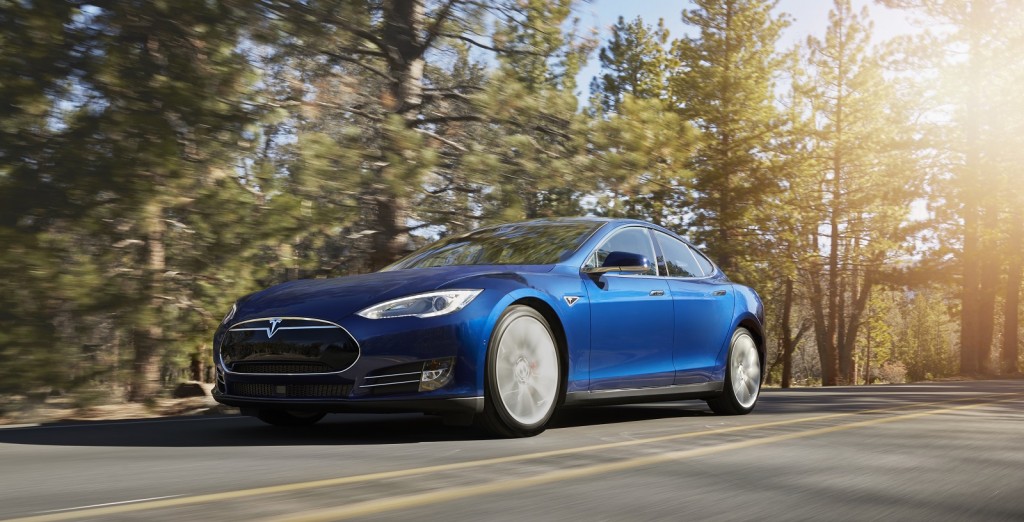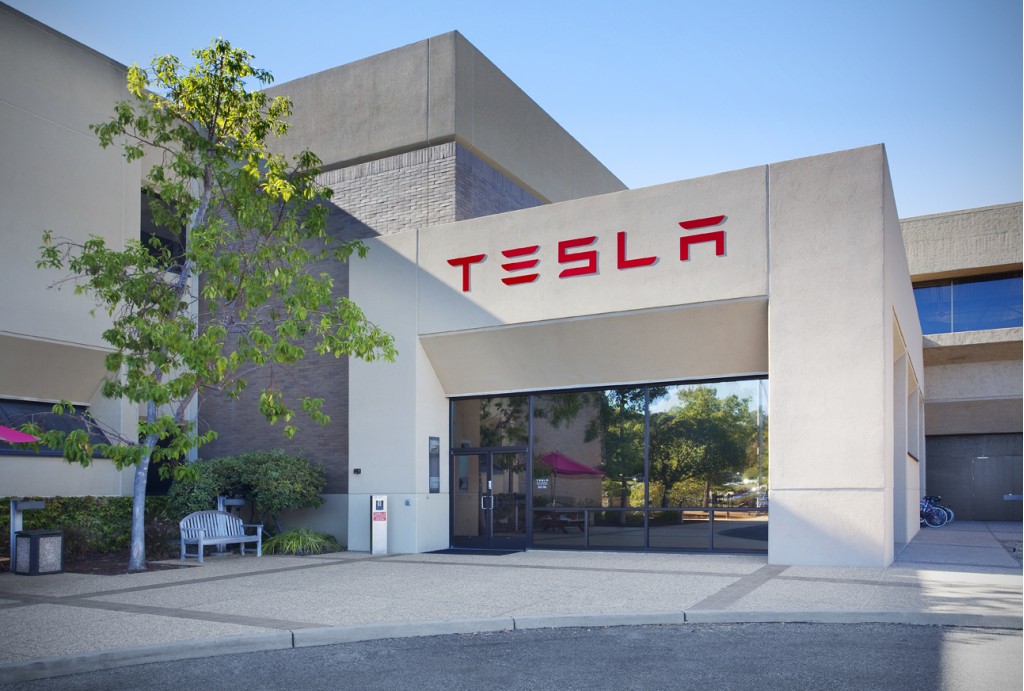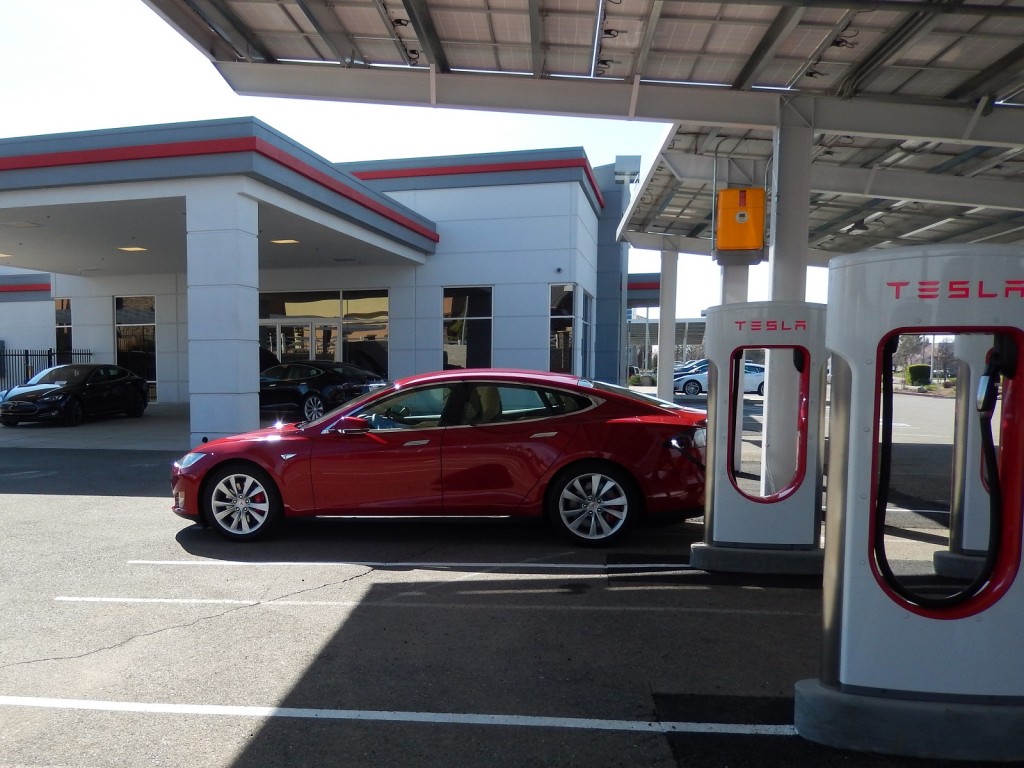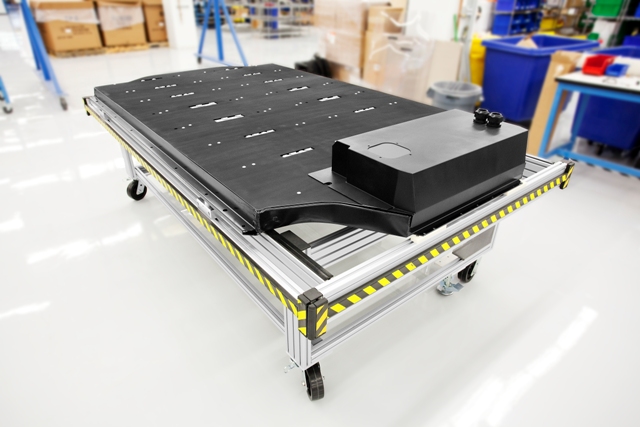
2015 Tesla Model S 70D in new Ocean Blue color
One of the myriad advantages of electric propulsion, we’re told, is the efficiency of all-wheel drive.
The AWD versions of the Tesla Model S, for example, are rated as more efficient than the rear-wheel-drive versions of the car.
This flies in the face of 100 years of automotive history, during which vehicles with gasoline or diesel engines and all-wheel drive invariably paid an efficiency penalty.
DON'T MISS: Tesla Model X gets new 75D base version, replacing 70D that was never built
That was due to the extra weight and higher driveline friction inherent in conventional mechanical AWD systems.
When Tesla introduced its first dual-motor all-wheel-drive Model S electric car, in late 2014, the EPA efficiency ratings for the Model S 85D were 12 percent better than its single-motor predecessor, the S 85.
The 85D is rated at 100MPGe, compared to 89 MPGe for the 85. Measuring in kilowatt-hours used per 100 miles, the EPA says the 85D uses 34 kwh compared to the 85’s 38 kwh.
![2015 Tesla Model S P85D - 'Chiseled by man and nature' [photo: George Parrott] 2015 Tesla Model S P85D - 'Chiseled by man and nature' [photo: George Parrott]](https://images.hgmsites.net/lrg/2015-tesla-model-s-p85d--chiseled-by-man-and-nature-photo-george-parrott_100509286_l.jpg)
2015 Tesla Model S P85D - 'Chiseled by man and nature' [photo: George Parrott]
By either metric, that’s a 12-percent efficiency advantage for the 85D.
When the dual-motor 70D was introduced in April 2015, it, too was rated more efficient by the EPA than the rear-wheel-drive S60 it replaced—this time, by 6 percent.
How the heck did Tesla do that?
CHECK OUT: Tesla Model S Dual-Motor Is Quicker, Has Higher Range Too: How Do They Do That? (Oct 2014)
“Because we have two drive units, we can shift the power from front to rear," Tesla Motors CEO Elon Musk explained at the time, "and constantly be at the optimal efficiency point for each motor."
"We’re actually able to overcome the penalty of the increased mass of the motor."
Tesla patent documents suggest that the rear motor is tuned and geared for acceleration, while the front motor is tuned and geared for efficient highway cruising.

2016 Tesla Model S P90D and Boeing 737 drag race
The car’s computer calls on whichever motor, or combination of motors, can deliver the required power most efficiently. The result: higher overall efficiency than a single-motor RWD car.
That’s the theory, anyway. And it’s a theory firmly backed up by the Teslas’ official EPA efficiency numbers.
But I’m sorry. I ain’t buying it. At least not all of it.
Real-world experience
In addition to 60,000 miles and more than three years behind the wheel of my 2013 Model S 85, I’ve spent time in both the 70D and the 90D (the successor to the earlier Model S 85D).
ALSO SEE: 2016 Tesla Model X electric SUV first drive by Model S owner
In warm weather, my single-motor S 85 typically registers energy consumption of 290 to 300 Watt-hours per mile (Wh/mi) in my normal driving.
Since the 90D and 70D are claimed to be 12 to 13 percent more efficient than my car, I had expected them to show me readings in the 260 to 270 Wh/mi range.
But neither car came anywhere close to that.
During my 30-mile test drive of the 70D, I averaged 289 Wh/mile—virtually the same as the 291 Wh/mi my car registered during the 70-mile round-trip drive to the test site, under similar road conditions.
I later happened upon a 70D at the Tesla Supercharger in Moab, Utah. I asked the driver if I could check his lifetime efficiency number.

2015 Tesla Model S 70D in new Ocean Blue color
Sure enough, after 20,000 miles, he showed 320 Wh/mi—virtually the same as my lifetime number.
Why wasn’t it 13 percent better?
More recently, I put in 60 miles behind the wheel of a 90D, averaging 326 Wh/mi. Under the same conditions, over mostly the same roads, my 85 had used 305 Wh/mi.
Other Model S owners have reported similar results.
WATCH THIS: Tesla Model 3: video of first ride in prototype $35k electric car
Last year, a pair of enterprising Washington state Model S owners—one 85, one 85D—made a 566-mile trip together, essentially in formation. The 85D used 6 percent more juice for the trip.
In the real world, my eyes (and those of other Tesla owners) tell me that the EPA efficiency numbers for the "D" all-wheel-drive Teslas are way off.
EPA numbers don’t add up
Not only are they way off, they don’t even jibe mathematically with the cars’ EPA range numbers.
All else being equal, either the range numbers or the efficiency numbers of the D models have to be wrong.
For example, compare my 85 to the now-discontinued 85D.

Tesla Model S 85D, 2015 Detroit Auto Show
The 85D is supposedly 12 percent more efficient than the 85. With the same battery energy available, by definition the 85D must have 12 percent more range.
(That’s the definition of efficiency: the ratio of distance traveled to energy consumed.)
My car’s EPA range is 265 miles. The 85D, with presumably the same battery and a 12-percent efficiency edge, should have a range of 297 miles.
But it doesn’t. The 85D’s EPA range is just 270 miles—less than 2 percent better than my 85’s number.
So something seems to be fishy with the numbers.
90D and 70D, too
The numbers for the 70D and 90D are similarly askew.
With its 12-percent efficiency advantage and 6-percent larger battery, the 90D should—all else being equal—have a range that’s 19 percent better than my 85. (1.12 x 1.06 = 1.19.)
That would give it a range rating of a whopping 315 miles. But ... sorry, not even close.
![2016 Tesla Model S 90D during Southern California test drive [photo: David Noland] 2016 Tesla Model S 90D during Southern California test drive [photo: David Noland]](https://images.hgmsites.net/lrg/2016-tesla-model-s-90d-during-southern-california-test-drive-photo-david-noland_100545570_l.jpg)
2016 Tesla Model S 90D during Southern California test drive [photo: David Noland]
The 90D’s EPA range is 288 miles, only a 9-percent improvement. (Earlier this week, the 90D’s range number was bumped to 294 miles—still well short of where it should be with its claimed efficiency.)
Compared to the RWD S 60 it replaced, the 70D—with a battery 17 percent bigger giving a supposed 6-percent better efficiency—should theoretically have 24 percent more range.
But in fact the range is only 15 percent better: 240 miles vs 208. If the 70D were as efficient as its EPA numbers suggest, it would have a range of 258 miles.
You could make a pretty good argument that, with a 17-percent bigger battery that gives only 15 percent more range, the 70D must be less efficient than the 60.
Tesla mum, EPA coy
I asked both Tesla Motors and the EPA about these mathematical discrepancies.
A Tesla spokesperson, apparently misunderstanding my question, responded with boilerplate descriptions of EPA test procedures and dual-motor dynamics that entirely missed the issue.
Two follow-up queries to Tesla went unacknowledged.

Tesla Motors, Palo Alto, California
An EPA spokesperson responded quickly, and eventually I talked to an engineer at the laboratory in Ann Arbor, Michigan, where the EPA tests electric cars.
He suggested that the discrepancy may be not in the numbers, but in my assumption that the 85 and the 85D have the same battery energy available.
“You should consider the possibility that the manufacturer may have different battery management for the two cars,” he said coyly.
A single test
Both the EPA range and efficiency numbers come from the same test: a fully-charged car is placed on a dynamometer and driven through a precise test protocol, until the battery is exhausted and the car stops. That gives the range number.
To test the efficiency, the car is then plugged in and fully recharged. The amount of electricity required to fully recharge the battery is then divided by the range number.

2013 Smart ForTwo Electric Drive Cabrio, Ann Arbor, Michigan, Aug 2013
The result is the efficiency rating, stated in kwh per 100 miles.
(The MPGe rating is calculated from this number with a conversion factor that accounts for the amount of energy in 1 gallon of gasoline.)
The EPA engineer confirmed that in the agency’s tests, the amount of electrical energy it took to recharge the 85 and 85D were in fact different.
Unfortunately, he could not tell me those numbers. They are considered to be "Confidential Business Information" and cannot be revealed to the public.

2015 Tesla Model S 70D in new Ocean Blue color
I hung up the phone both surprised and frustrated. Surprised that the 85 and 85D had different battery energy available. And frustrated that I didn’t know how different they were.
Duh….
But then the light bulb went on.
The supposedly “confidential” numbers were hiding in plain sight, easily derived from the published EPA numbers: available battery energy was simply efficiency multiplied by range.
If the single-motor 85 uses 38 kwh per 100 miles and has a range of 265 miles, then the total energy used is 38 x 265/100, or 38 x 2.65. That works out to 101 kwh.
For the 85D, the number is 34 x 2.70, or 92 kwh.
(The EPA subsequently confirmed that these numbers were accurate.)

2015 Tesla Model S P85D Supercharging in Rocklin, California, Feb 2015
But wait—the EPA measured the amount of electricity that came out of the wall plug. That’s not the same as the energy that actually went into the battery.
The difference is due to charging losses, which typically amount to about 15 percent.
If we reduce both of these numbers by 15 percent, we arrive at the following conclusions:
- The single-motor 85 had available 86 kwh of battery energy in the EPA test.
- The 85D had only 78 kwh.
Two mysteries
First, I’m suspicious of that 86-kwh number for the single-motor 85.
Rounding errors aside, batteries typically have software-controlled “buffers” that prevent the battery from discharging down to absolute zero, which can cause long-term damage.
I’d be quite surprised if more than 80 kwh were available in the nominally 85-kwh Tesla battery.
The 86-kwh number assumes charging losses of 15 percent, but perhaps actual losses were higher.
![Tesla Model S lithium-ion battery pack in rolling chassis [photo: Martin Gillet via Flickr] Tesla Model S lithium-ion battery pack in rolling chassis [photo: Martin Gillet via Flickr]](https://images.hgmsites.net/lrg/tesla-model-s-lithium-ion-battery-pack-in-rolling-chassis-photo-martin-gillet-via-flickr_100481091_l.jpg)
Tesla Model S lithium-ion battery pack in rolling chassis [photo: Martin Gillet via Flickr]
If we assume 20-percent charging losses, the battery energy figure would be a more reasonable 81 kwh.
But whatever the charging losses, the fact remains: In the EPA tests, the dual-motor 85D used 10 percent less out-of-the-wall-plug electricity than the single-motor 85.
Why? I see three possibilities:
(1) The all-wheel-drive D batteries have lower total energy capacity.
Did Tesla have to remove one or two of the Model S’s 16 battery modules to make room for the front motor? That would reduce battery capacity by 6 to 12 percent.
My own testing of my 85’s maximum usable capacity showed about 75 kwh when new. Other owners have reported similar numbers for their 85s.
But a P85D owner recently reported on a Tesla forum that he had used 70.3 kwh while discharging from 99 percent to 1 percent. That equates to a max usable capacity of 71.7 kwh—about 5 percent lower than the 85.
This gap could reflect a smaller total battery capacity. Or it might be due to the possibility that….
(2) The D cars are software-limited to leave a larger “buffer” of unused energy in the battery.
This is more or less what the EPA engineer hinted at.

Tesla Motors - Model S lithium-ion battery pack
To my non-expert eye, however, there is no clear reason why this would be necessary.
(3) The D cars have more efficient chargers.
For a given battery energy, the D cars would require less out-of-the-wall-plug electricity, thereby fooling the EPA testing protocol into rating the car as more efficient than the single-motor cars.
This would at least explain why I found no actual efficiency gains in real-world driving.
Frankly, none of these possibilities seem very likely.
I’m stumped. Any ideas out there?
_______________________________________












